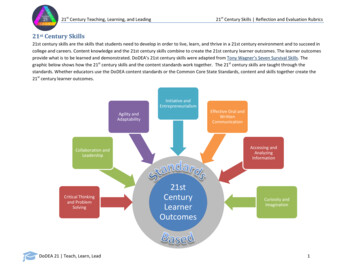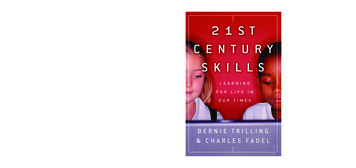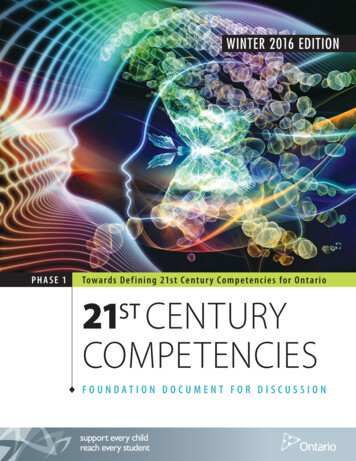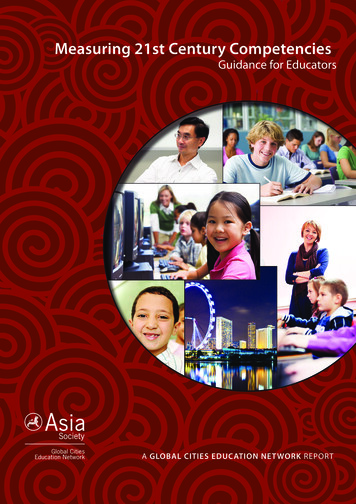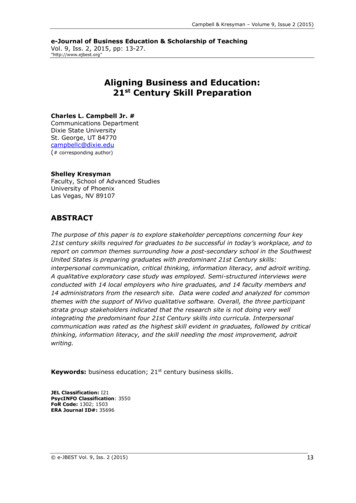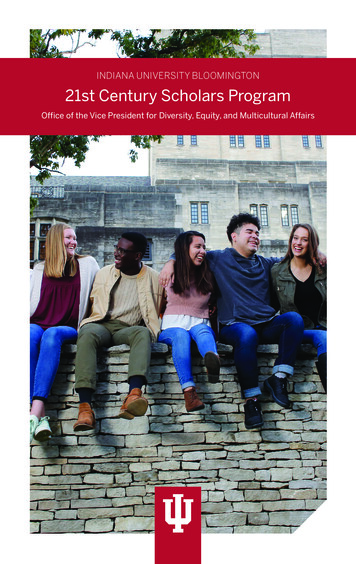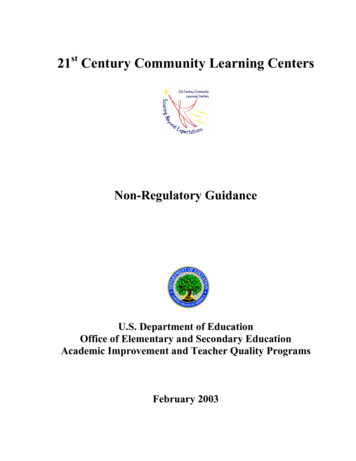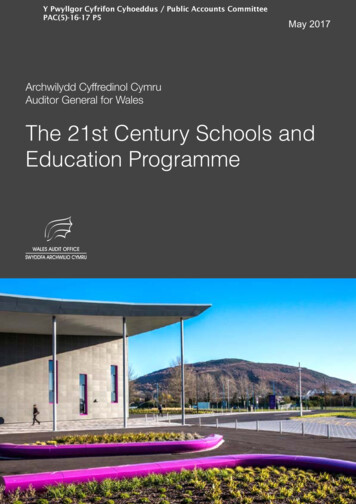
Transcription
21st centurylearningenvironmentsLLLP - POSITION PAPER - 2019
3LLLP POSITION PAPER - 21ST CENTURY LEARNING ENVIRONMENTSTable of contentsLifelong Learning Platform “21st century learning environments”Position paper - October 2019Chief editor:Brikena Xhomaqi, Director, Lifelong Learning PlatormEditor:Andrew Todd, Policy and Advocacy Coordinator, Lifelong Learning PlatformCo-editors:Pauline Boivin, Project and Policy Coordinator, Lifelong Learning PlatformJuanma Báez Ramírez, Policy and Project Assistant, Lifelong Learning PlatformContributors, from the European Association for Research on Learning and Instruction (EARLI):Dr Alessio Surian, University of PadovaDr Lina Markauskaite, The University of SydneyProf Stephen Billett, Griffith UniversityThomas Kaye, Vrije Universiteit AmsterdamDr Riikka Hofmann, University of CambridgeSonia Felix, University of LisbonProf Martin J. Tomasik, University of Witten-Herdecke and University of ZurichCarolien van Campen, Radboud UniversityDr Elizabeth Koh, Nanyang Technological University, SingaporeDr Andreas Gegenfurtner, University of PassauSamantha Newell, University of AdelaideLisette Wijnia, HZ University of Applied Sciences / Erasmus University RotterdamProf Hanni Muukkonen, University of OuluLoulou Detienne, University of GhentDesign and illustrations:Andrea Lapegna, Communication and Campaign Coordinator, Lifelong Learning PlatformWith the financial support of the European UnionIntroduction: setting the scene4Main recommendations6What is a learning environment?8Shifting from education to learning: all learning made equal1021st century, so what? Space, time, and societal transformation12Local communities: a shared learning environment15Build the environment around the learner17Who controls the environment?1921 century teaching and learning methods21Giving learners a toolkit for the 21st century23All learning made equal, all learning made visible26Connecting the dots: cooperation is key for sustainable lifelonglearning30
421ST CENTURY LEARNING ENVIRONMENTS - LLLP POSITION PAPERLLLP POSITION PAPER - 21ST CENTURY LEARNING ENVIRONMENTS5INTRODUCTION:setting the sceneLearning can happen anytime, anywhere,and the spaces where this learning occursare incredibly and increasingly diverse.Education systems are undergoing aparadigm shift in the struggle to meetthe needs of learners in a world that israpidly changing from a technological,demographic, societal and environmentalperspective. The rich diversity of learningenvironments, whether within the formaleducation system or beyond in the localcommunity, workplace or civil society, ismore valuable than ever to meet theserapidly evolving needs. Learning takes placeacross a combination of these environments,hence why we see increasing reference tothe term ‘lifewide’ learning - where peopleengage simultaneously in different formsof learning at the same stage of their lives.1However,thesediverselearningopportunities are not equally availableto all sections of society and, even whenavailable, the outcomes of learning outsideformal settings are often not regarded inthe same way as those produced withinthem. Even the outcomes of formal learningcan be difficult to transfer from one systemto another, if a robust strategy for therecognition of prior learning is not in place.This clashes with the fact that the sheerpace of change in the 21st century compelsus to continue learning throughout andin many different areas of our lives if wetruly wish to understand, adapt to and,most importantly, shape the world aroundus. This demands that we designate equalvalue to all learning environments whether categorised as formal, non-formal,informal or combining varying degrees of(in)formality - and reflect on how to buildcooperation and seamless transitionsbetween them. Such a shift is a necessarystep towards enacting the first principleof the European Pillar of Social Rights2,meeting the objectives of the strategicframework for European cooperation ineducation and training3, and achieving theUN Sustainable Development Goal 4 by20304.This shift is at the heart of the LifelongLearning Platform’s mission. Our policypaper seeks to encourage a debate andprovide recommendations by illustratingthe diversity of learning environments,the value of building these around thelearner’s needs, the need for robustvalidation arrangements for the learningoutcomes that they produce and, finally,the importance of building cooperationbetween them.It should be highlighted that theimplementationofthefollowingrecommendations demands a robust andholistic investment in education in itswider scope (lifelong learning), whichrequires both the public and private sectorin light of training at the workplace, aswell as more systematic and streamlinedcoordination between different ministries ordepartments whose policies and initiativestouch on learning environments, whichmay include culture, employment, health,research, digitalisation and sustainabledevelopment, among others.Jackson, Norman Jeffrey (2011). Learning for a ComplexWorld: A lifewide concept of learning, education and personaldevelopment. United States of America: Authorhouse.1Everyone has the right to quality and inclusive education,training and life-long learning in order to maintain andacquire skills that enable them to participate fully in societyand manage successfully transitions in the labour market.See the full list of 20 principles here.23ET2020 FrameworkSustainable development goal 4 Ensure inclusive andequitable quality education and promote lifelong learningopportunities for all4
6LLLP POSITION PAPER - 21ST CENTURY LEARNING ENVIRONMENTS21ST CENTURY LEARNING ENVIRONMENTS - LLLP POSITION PAPERMAIN RECOMMENDATIONSPotentialIntegrate a more nuanced understanding of learning environments into education,training and lifelong learning policies, guided by the overarching principle to supportlearners’ individual and unique potential. This means recognising, including throughsustained investment, the value of learning environments beyond formal academiceducation as dynamic hubs of competence development - from which the latter canalso draw expertise in adopting more inclusive and innovative approaches to meetinglearners’ needs.educatorsRecognise the role of teachers and educators in the 21st century as facilitators, notdirectors, of learning with the necessary resources, training and policies to supportthem in managing the rapid changes that they are facing. Recognising the reality ofthis new role also means integrating into our education and training policies a morecontemporary understanding of who an “educator” can be, including trainers andfacilitators who work with learners outside the formal environment.participationflexible pathwaysFoster flexible learning pathways by supporting people in accessing and movingacross learning environments as they progress through life, in accordance with theirneeds and regardless of age or background. This can be achieved through measureslinked to modular or ‘micro-learning’ approaches, shorter study cycles and enhancedarrangements for the validation of prior learning of all types, as well as quality lifelongguidance which empowers individuals in managing their own learning and career pathsand better reconciling their personal and professional lives. All this is crucial to boostlearning motivation, avoid ‘dead ends’ and ensure that no learners are left behind.DIGITALPromote the purposeful use of digital and blended learning environments to offerwider and more personalised access to lifelong learning based on the understandingthat they cannot replace face-to-face learning, in line with a holistic approach topersonal development. This means making use of the diverse range of spaces that maysupport learning processes, including in the outdoors and local communities.CommunityUpscale the concept of ‘Community Lifelong Learning Centres’, building on existingpractices, in order to enhance integrated service delivery while catering for thelearning needs of local communities. This is particularly relevant for marginalised orminority groups who are least likely to avail of lifelong learning opportunities.co-creationDesign learning environments based on a needs-centred approach, with the aimto ensure learners’ role as active co-creators of knowledge and their environment.This also means flexibility in the design and arrangement of the physical space wherelearning occurs and allocating resources from national and EU funds, including thefuture InvestEU programme, to support this across the full spectrum of education andtraining providers.Provide concrete support and resources for the integration of participatory pedagogy,including collaborative, peer-to-peer, dialogic and inquiry-based approaches, inorder to ensure the active and meaningful participation of learners. More flexibilityin adapting curricula and assessment methods is a vital step towards achieving this.competencesRecognise that competences for the 21st century are not only digital or technical innature but encompass learning to learn as a competence in its own right and other“life skills” which support individuals’ resilience and participation in wider society.The development of such competences should be supported from the beginning ofand across the lifelong learning continuum, including through investment in nonformal and informal learning environments which are particularly relevant in terms ofacquiring these competences.VALIDATIONPrioritise the implementation of arrangements for the validation of non-formaland informal learning which is imperative to give value and visibility to all learningirrespective of the environment where it takes place, especially for learners with a lowlevel of or an adverse experience with formal education. These arrangements shouldbe universally accessible, inspired by the key guiding principle of social equity as wellas the meaningful participation of stakeholders from all sectors affected by validationprocesses.cooperationSystematically build cooperation and partnerships between and across formal, nonformal and informal learning environments, at regional, national and European level,including support for their representative associations at these different scales, inorder to facilitate innovation transfer and foster coherent lifelong learning approachesthat take into account and bring together the different aspects of individuals’ lives.7
821ST CENTURY LEARNING ENVIRONMENTS - LLLP POSITION PAPERLLLP POSITION PAPER - 21ST CENTURY LEARNING ENVIRONMENTS9WHAT IS A LEARNINGENVIRONMENT?Before dwelling on the learning aspect, itis useful to reflect on what we understandan environment to be. More than just thespace around us in any given location,an environment may be considered amulti-modal hybrid phenomena thatinvolves social, cognitive, cultural andbiological interacting modalities, as wellas “relational” phenomena, i.e. there isno environment unless there are agentswho interact and enact its affordances5.This is important to consider in a learningcontext because the learner, as an agent,is confronted with other phenomena(including other agents) and much of thelearning occurs through those interactions.This evokes different notions that arediscussed throughout the paper from themicro-level, such as elements related tolearners’ agency and the shaping and cocreation of their learning environments,to the macro- or system level, namely thepolicies that shape the everyday reality oflearning environments and where they fitin the socio-political order.The term “learning environment”specifically may be defined orconceptualised in different ways.The Glossary of Educational Reformdescribes it as follows:‘Learning environment refers to the diversephysical locations, contexts, and cultures inwhich students learn. Since students maylearn in a wide variety of settings, such asoutside-of-school locations and outdoorenvironments, the term is often used asa more accurate or preferred alternativeto classroom, which has more limited andtraditional connotations—a room with rowsof desks and a chalkboard, for example6.The term also encompasses the culture ofa school or class—its presiding ethos andcharacteristics, including how individualsinteract with and treat one another—aswell as the ways in which teachers mayorganize an educational setting to facilitatelearning .’Variety in settings and contexts isfundamental because not one type ofenvironment can have a monopoly onlearning, even if the formal education systemand the policies that shape it may tend togive the opposite impression. In essence,learning is a personal process which formspart of the human experience and, as such,it does not depend on formal educationprovisions7. The above definition alsoreinforces the notion of learners relatingto and interacting with each other, as wellas evoking the idea of how the physicalspace itself is arranged. These are elementsanalysed below when we consider how tobuild the learning environment around theindividual with a view to maximising her orhis learning potential.The Organisation for Economic Cooperationand Development (OECD) also looks atsuch concepts and principles in its 2017study on Innovative Learning Environments(ILEs). Here a learning environment isdescribed as one which “includes theactivity and outcomes of learning, ratherthan being just a location where learningtakes place”8. This calls for reflection onhow learners participate in the “activity”and on what they do with the “outcomes”after their experience in any given learningenvironment. This is crucial when it comesto the question of what support exists atthe system level for the recognition andvalidation of learning outcomes.Markauskaite, L., & Goodyear, P. (2017). Epistemic fluencyand professional education: Innovation, knowledgeableaction and working knowledge. Dordrecht, The Netherlands:Springer.56Ed Glossary, «learning environment»Billett, S. (2010) The perils of confusing lifelong learningwith lifelong education. International Journal of LifelongEducation 29 (4) 401-413.78OECD (2017) Innovative Learning Environments, p.16.
1021ST CENTURY LEARNING ENVIRONMENTS - LLLP POSITION PAPERLLLP POSITION PAPER - 21ST CENTURY LEARNING ENVIRONMENTS11SHIFTING FROM EDUCATION TOLEARNING:ALL LEARNING MADE EQUALAcross most academic and policy contexts,learning tends to be categorised as‘formal’, ‘non-formal’ or ‘informal’. Formaleducation or learning is learning that isorganised and structured as part of a clearlydefined curriculum and leads to formallyrecognised qualifications from institutionssuch as schools and universities. Due toits official character or ‘concreteness’, thisis usually the category most privilegedby policymakers and wider society. Nonformal learning tends to be understood asvoluntary learning which happens outsidethis formal system but remains intentionaland structured to a certain extent withina programme delivered by an organisation(e.g. work-based training). Informal learning,on the other hand, is usually understoodas ‘experiential’ in the sense that it is notinstitutionalised, planned or structuredand typically occurs through an individual’severyday activities and interactions (e.g.learning among family and friends).Of course, this is a rudimentary overviewand the above categorisations are subjectto contested debate. Crucially, there isa school of thought which questionsthe utility of labelling learning in thisway and considers it more accurateto speak about the degree of formalityor informality in learning, because theseare characteristics present in all situationswhere learning occurs9. Indeed, theboundaries between what are perceived asformal, non-formal and informal learningenvironments are rarely clear-cut. Thereare cases where non-formal educationmethods are used in the school classroom,a distinctly formal environment10. Anothercase is at universities where multipleenvironments may sit closely side-byside for students who, besides attendinga formal course, live in halls of residencewhich form a “vibrant and diverse all-roundliving and learning environment” wherethe learning process “extends beyondthe classroom to involve a wide rangeof experiences: from moving away fromhome for the first time; to sharing a livingspace; to participating in the wide rangeof (.) activities and programmes on offeras part of university life”11. This transitionbetween learning environments not onlyhappens horizontally across differentcontexts (‘lifewide’) but also verticallythrough time (‘lifelong’) when we consider,for example, non-traditional students suchas experienced workers who enroll in aformal degree programme after developingskills at the workplace. This shows thatlearning environments of different typesare not mutually exclusive but peoplemove between them in an infinite varietyof ways.In many respects, an understanding of thisbroad nature of learning environments isabsent from education and training policiesacross the EU, or where they acknowledgethis they tend to do so only superficially orinconsistently. At the EU level, for instance,although the Key Competences for LifelongLearning Framework12 provides a strongbasis, inconsistencies arise when otherinitiatives such as those related to theEuropean Education Area do not addresslearning beyond the formal sector, or in thecase of the 2018 Education and TrainingMonitor which looked at the acquisitionof civic competences through non-formaland informal learning exclusively in termsof youth work, thus neglecting its muchbroader scope.All in all, formal (academic) education stillremains the main driver of the learningecosystem, while vocational education andtraining, non-formal and informal learningremain, to varying degrees, secondary inesteem or recognition. Although formaleducation still holds an essential role in oursocieties, and its quality and inclusivenessshould be guaranteed, a shift is neededtowards a lifelong learning paradigm wheresupporting the individual’s potential is thekey guiding principle. This means equalrecognition and value for all learningenvironments and the possibility to moveseamlessly between them.Colley, H., Hodkinson, P. & Malcolm, J. (2003). Informalityand formality in learning: a report for the Learning and SkillsResearch Centre.910CARMA projectEuropean University College Association (EuCA) (2012).Soft skills in action: Halls of residence as centres for life andlearning.11Council Recommendation of 22 May 2018 on keycompetences for lifelong learning.12
1221ST CENTURY LEARNING ENVIRONMENTS - LLLP POSITION PAPERLLLP POSITION PAPER - 21ST CENTURY LEARNING ENVIRONMENTS1321ST CENTURY, SO WHAT?SPACE, TIME, and societaltransformationThe rapidly growing use of digitaltechnologies has given rise to new digitaland blended learning environments,opening possibilities for wider access toknowledge and more personalised learningprocesses13. A wealth of new opportunitiesfor learning are available thanks to MOOCs,online tutoring and video platforms suchas Youtube where one can find tutorialsabout almost everything. In fact, a 2018research study in the United States foundthat 51% of Youtube users say that thewebsite is very important for them tolearn how to do new things14. Not only hasdigital technology expanded opportunitiesfor non-formal and informal learning inthis way, it has implications for formalenvironments such as schools because itbreaks their monopoly on the transmissionof knowledge and challenges howthey organise time, space andtheir internal structure15. It opensthem to the world beyondtheir walls. So, althoughdifferent types of learningenvironments will alwayshave their own needs and particularities,the digital wave has further loosened theboundaries between them.This loosening of boundaries equally hasa temporal dimension as learners are lessand less likely to fit into the linear patternof school-work-retirement. It is no longerthe norm and more needs to be doneto support individuals in accessing andmoving across learning environments asthey progress through life, in accordancewith their needs and regardless of age,ableness or socio-economic background.Otherwise, learners with a low level offormal qualifications or low-skilled workersin pursuit of retrainingare at a disadvantage.There are various waystopromoteflexible learningpathways,includingmodularor ‘microlearning’21st century learning environments wherespace and time are rendered flexible thanksto innovative technologies, includingartificial intelligence. Despite the manyadvantages that their carefully planned usecan bring such as saving time, selectionof the most relevant content, etc., theycannot replace face-to-face learning. Aholistic approach to human developmentthat caters for individuals’ well-being andmakes use of the full range of learningenvironments available to us, not onlyonline but also offline, is crucial. Outdoorlearning is a concrete example. There is asubstantial body of evidence documentingthe positive effect that learning in naturalIt is a common claim that the future of learning environments can have on children’s health,is digital, that this is the defining feature of well-being, competence development andapproaches, shorter study cycles, enhancedarrangements for the validation of priorlearning of all types (more on this below)and indeed the purposeful use of digitaltools. This flexibility is key to boost learningmotivation and widen access to lifelonglearning, so that it can fit easily into people’sbusy lives. When it comes to adult learningin particular it is difficult to imagine, withoutsuch flexibility, how an ambitious targetof 25% for participation in adult learning,proposed by the European Commissionunder the vision for a European EducationArea16, could be achieved while the currentrate stands at a modest 11.1%17.European distance e-learning network (eden)The Support Future Learning Excellence through Micro–Credentialing inHigher Education (MicroHE) project aims to gather the state of the art in microcredentialing in European higher education, forecasting the impacts of continuedmodularisation of higher education, examining the adequacy of Europeanrecognition instruments for micro-credentials, and developing an online clearinghouse to facilitate recognition, transfer and portability of micro-credentials inEurope.BEST PRACTICE
14LLLP POSITION PAPER - 21ST CENTURY LEARNING ENVIRONMENTS21ST CENTURY LEARNING ENVIRONMENTS - LLLP POSITION PAPEREuropean university continuing educationnetwork (eucen)Through Digital Wellbeing Educators, eucen aims to increase the capacity oflecturers and teachers to integrate digital education in a way that promotes thedigital wellbeing of students. Through building teacher capacity, the project seeksto improve students’ abilities to manage their online time, make the most ofdigital learning, critically assess the media they consume and create and becomeresponsible, confident digital citizens.BEST PRACTICEenvironmental attitudes in adulthood18. In find solutions.a lifelong learning perspective this aspectof learning in outdoor environments,either informally or integrated into formal 13 LLLPlatform (2017), Reimagining Education for the Digitalor non-formal education programmes, Age, Position Paper, P.6is important to consider in the face of 14 Pew Research Center (2018) «Many Turn to YouTube forclimate change and other ecological crises Children’s Content»15Plataforma para o Crescimento Sustentável (PCS) (2019)as a way to foster connection with the«Reshaping Schools for a T-World»natural world. Therefore, learning in the 16European Commission (2017). Strengthening European21st century should not only be about Identity through Education and Culture: The Europeanadapting to digitalisation, or seeking to Commission’s contribution to the Leaders’ meeting indigitalise all learning environments, but 17Gothenberg, 17 November 2017. COM/2017/0673 final.European Commission (2019). Education and Trainingabout addressing the full array of societal Monitor2019. SWD(2019)350challenges we are confronted with and 18 Malone, K. and Waite, S. (2016) Student Outcomes andusing all possible learning spaces to help us Natural Schooling. Plymouth: Plymouth University.ALL DIGITALDigital Competence Development System (DCDS) aims to establisha framework that provides the low-skilled adult European populationwith the basic digital and transversal competences for employment,personal development, social inclusion and active citizenship.The project developed an open, innovative multilingual DigitalCompetences Development System (DCDS) to provide non-formaltraining to low-skilled adults. Face-to-face training is indispensablefor low-skilled adults and that technology can have a supportive rolebut it cannot replace in person learning.BEST PRACTICE15LOCAL communities:a shared learningenvironmentIf the natural world can be a learningenvironment, so too can our localcommunities which act as vibrant hubs ofeveryday activities and interactions. Formaleducation institutions such as schools anduniversities have a general tendency to beclosed off from the communities in whichthey are located, serving only their enrolledstudents and lying empty during eveningsand weekends. Instead, we shouldconnect learning environments with theircommunities and open them up to otherusers in the local area. This could be throughCommunity Service Learning initiatives(see project below) or by establishing“Community Lifelong Learning Centres”that can cater to the needs of those peoplenot in education, training or employmentor the general public interested in furtherpersonal and professional development19.Many inspiring practices based on thisconcept already exist across the EU, asshowcased at the joint Cedefop-LLLPpolicy forum “What role for communitylifelong learning centres? The potential ofone-stop shops for preventing youth atrisk from disconnecting” which took placein Brussels on 29 May 201920. It has alsobeen the basis for national programmes,like in Latvia where the initiative “Schoolsas Community Development Centres” wasimplemented as a way to sustain smallschools in rural areas while using them tohost extracurricular and adult educationactivities21.The main advantage of Community LifelongLearning Centres is that they provide awelcoming environment, often combiningdifferent modalities of learning andoffering other personal and social servicesalongside these, which is accessible to thelocal community both in terms of physicalproximity and as places where learners,ERASMUS STUDENT NEtWORK (esn)SocialErasmus is an international project by the Erasmus Student Network (ESN)that promotes a social attitude among young citizens participating in mobilityprogrammes, to facilitate their integration into the local community while givesthem the chance to make a long lasting social change in society through volunteeringactivities. The project goes under the slogan: Leave your mark!BEST PRACTICE
16LLLP POSITION PAPER - 21ST CENTURY LEARNING ENVIRONMENTS21ST CENTURY LEARNING ENVIRONMENTS - LLLP POSITION PAPEREUROPEAN UNIVERSITY FOUNDATION (euf)University of Gent has developed the academic programme Community ServiceLearning (CSL), a form of experiential learning where students contribute to theircommunity by participating in professor-approved community service placementsrelated to course learning objectives and then produce corresponding reflectiveassignments.BEST PRACTICEincluding those from marginalised groups,feel a sense of safety and belonging. Thiscommunity-centred approach is a crucialelement in the vision for 21st centurylearning environments because it servesto open up lifelong learning opportunitiesat the local level, particularly for thoseindividuals least likely to participate informal education programmes.LLLPlatform (2019) LLLP Briefing Paper Implementing aholistic approach to lifelong learning: Community LifelongLearning Centres as a gateway to multidisciplinary supportteams.1920Cedefop (2019), Conclusions of the Policy Fourm.Tūna, A. (2015). Development of the School asMultifunctional Resource Community in Latvia: Opportunitiesand Challenges; Sociey, Integration, Education. Proceedingsof the International Scientific Conference. 1. 496.21EUROPEAN school headsassociation (esha)‘Open Schools for Open Societies’ aims to help a thousandEuropean primary and secondary schools with opening up to theircommunities. An “open school” is a more engaging environmentfor students and raises their motivation by connecting studentprojects with real needs from the community and drawingupon local expertise. The project includes the production ofguidelines on designing partnerships with local industries,research organisations, parent associations and policy makers.17build the environmentaround the learnerAccording to the OECD, the first principleof an innovative learning environmentis that its “recognises the learners as itscore participants, encourages their activeengagement and develops in them anunderstanding of their own activity aslearners” (emphasis added)22. It followsthat learners should be at the centre of allconsiderations when it comes to designingand supporting learning environments,whether at the micro- or macro-level.Attention must be paid to ensuring theirrole as active co-creators of knowledge andtheir environment, avoiding the outdatedidea of learners as passive listeners who fitinto rigid, pre-defined models and spaces.This means that the environment shouldfoster learners’ “agency”, understoodbroadly as the sense that they are doingor are able to do things, rather than thingsjust happening to them: in other words, asense of efficacy23.Crucially, to develop agency the learner“needs to be treated as an active subject,not just an object of upbringing oreducation”24. This means looking at thelearner’s intrinsic potential and enablinghim or her to discover and harness thispotential, no matter his or her past orba
6 21ST CENTURY LEARNING ENVIRONMENTS - LLLP POSITION PAPER LLLP POSITION PAPER - 21ST CENTURY LEARNING ENVIRONMENTS 7 MAIN RECOMMENDATIONS Integrate a more nuanced understanding of learning environments into education, training and lifelong learning policies, guided by the overarching principle to support learners' individual and unique .
